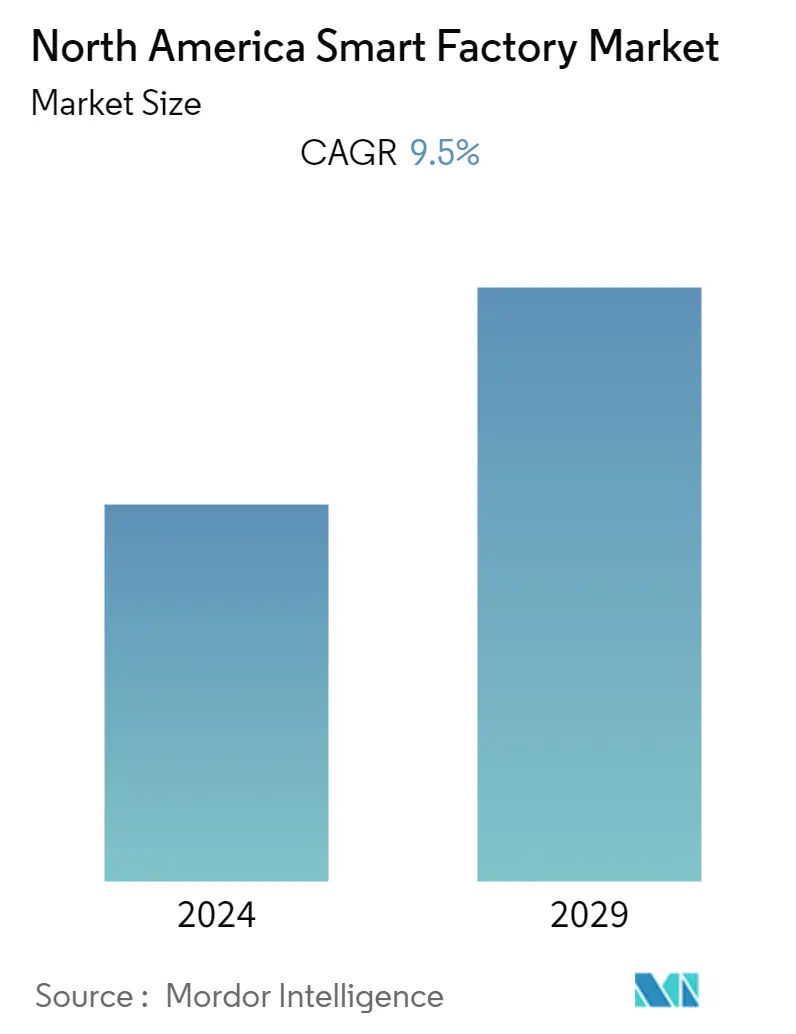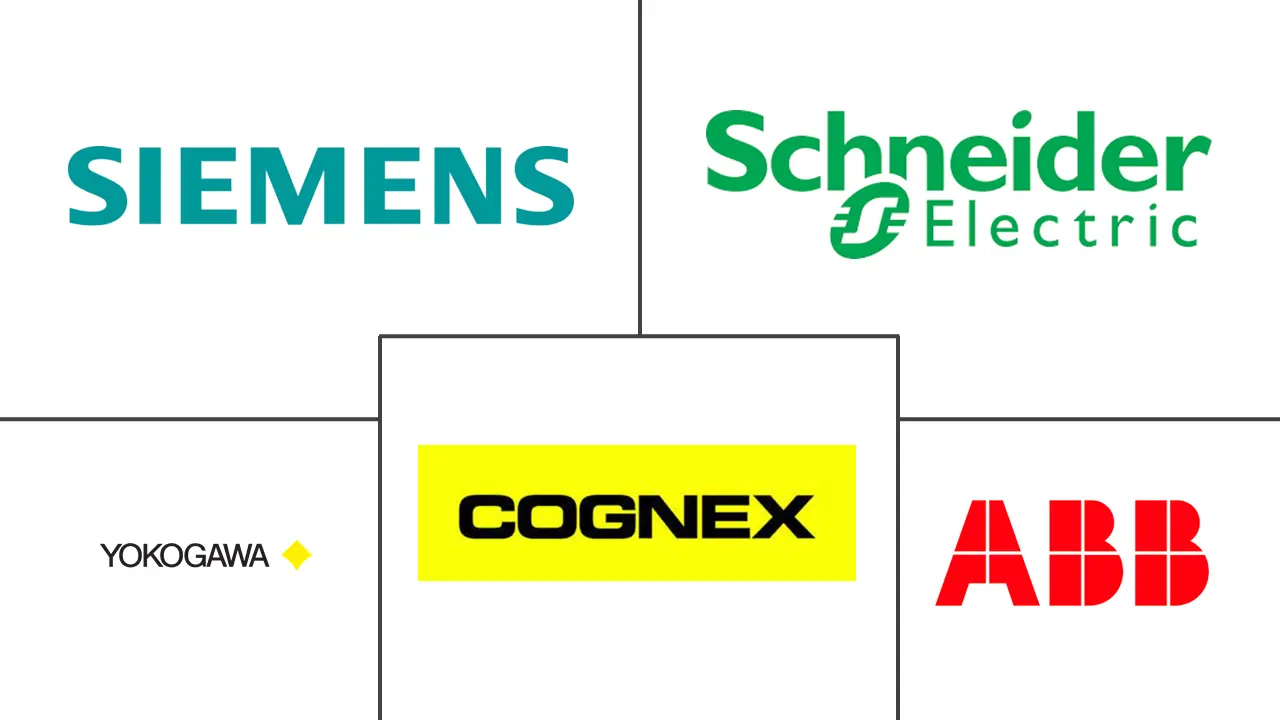
| Study Period | 2019 - 2029 |
| Base Year For Estimation | 2023 |
| Forecast Data Period | 2024 - 2029 |
| Historical Data Period | 2019 - 2022 |
| CAGR | 9.50 % |
Major Players
*Disclaimer: Major Players sorted in no particular order |
North America Smart Factory Market Analysis
The North America Smart Factory Market is expected to witness a CAGR of approximately 9.5% over the forecast period (2021-2026). The outbreak of COVID-19 has forced the manufacturing industries to re-evaluate their traditional production processes, primarily driving the digital transformation and smart manufacturing practices across the production lines. The manufacturers are also collectively being forced to devise and implement multiple new and agile approaches to monitor product and quality control.
- The Maryville University estimates that by 2025, over 180 trillion gigabytes of data will be created worldwide every year. A large portion of this will be generated by IIoT-enabled industries. A survey by the Industrial IoT (IIoT) giant, Microsoft, found that 85% of companies have at least one IIoT use case project. This number will increase, as 94% of the respondents said they will implement IIoT strategies by 2021.
- IoT technologies are overcoming the labor shortage in the manufacturing sector, especially in the developed countries, like the United States. Due to this, the Federal Government and the private sector in the United States are investing in Industry 4.0 IoT technologies, to increase the American industrial base, which was taken over by China and other low labor cost countries. Therefore, IoT technologies may mainly drive the adoption of smart factory solutions, across the world.
- Also, the recent increase in tariffs is likely to force manufacturers of the United States to produce goods at a lower cost, which is to be achieved through automation. Auto companies that invested in automation pre-tariffs are ahead of the game, and they are the cost-saving blueprint for other companies. Companies that produce industrial robots and automation products are set to benefit, as they are the largest producers of the robots and equipment needed for automation.
- Automation technologies, such as collaborative robots, require human intervention/ interaction. Furthermore, industrial control systems (ICS) are laced with security risks. Hence, ICS security solutions must be installed to prevent security threats to the systems, which increases the cost of maintaining ICS. Nevertheless, advancements in cybersecurity solutions are reducing the fear of security issues associated with ICS.
North America Smart Factory Industry Segmentation
The North American Smart Factory Market is segmented by product type, namely machine vision systems, and industrial robotics, among others, and by technology, which includes SCADA, PLC, and HMI, among others. The factories or manufacturing facilities in the North American region adopting smart technologies to enhance their operations are mainly considered under the scope of this study.
| Machine Vision Systems | Cameras |
| Processors | |
| Software | |
| Enclosures | |
| Frame Grabbers | |
| Integration Services | |
| Lighting | |
| Industrial Robotics | Articulated Robots |
| Cartesian Robots | |
| Cylindrical Robots | |
| SCARA Robots | |
| Parallel Robots | |
| Collaborative Industry Robots | |
| Control Devices | Relays and Switches |
| Servo Motors and Drives | |
| Sensors | |
| Communication Technologies | Wired |
| Wireless | |
| Other Products |
| Product Lifecycle Management (PLM) |
| Human Machine Interface (HMI) |
| Enterprise Resource and Planning (ERP) |
| Manufacturing Execution System (MES) |
| Distributed Control System (DCS) |
| Supervisory Controller and Data Acquisition (SCADA |
| Programmable Logic Controller (PLC) |
| Other Technologies |
| Automotive |
| Semiconductors |
| Oil and Gas |
| Chemical and Petrochemical |
| Pharmaceutical |
| Aerospace and Defense |
| Food and Beverage |
| Mining |
| Other End-user Industries |
| United States |
| Canada |
North America Smart Factory Market Size Summary
The North American Smart Factory Market is experiencing significant growth, driven by the need for digital transformation in manufacturing processes. The COVID-19 pandemic has accelerated this shift, prompting manufacturers to adopt smart manufacturing practices to enhance product and quality control. The integration of Industrial Internet of Things (IIoT) technologies is a key factor in this transformation, as it helps address labor shortages and boosts the industrial base in the United States. The market is also influenced by the need for automation to reduce production costs, especially in light of recent tariff increases. Companies producing industrial robots and automation products are poised to benefit from this trend, as they provide the necessary equipment for automation. Despite the challenges posed by security risks in industrial control systems, advancements in cybersecurity are alleviating these concerns, further supporting the adoption of smart factory solutions.
The electronics and semiconductor industries in North America are pivotal to the smart factory market's expansion. The region's demand for smartphones, consumer electronics, and smart wearables is driving the need for semiconductors, which are essential for advanced manufacturing processes. The automotive sector, particularly with the rise of electric vehicles and self-driving technology, is also a significant contributor to semiconductor demand. The pandemic has highlighted the semiconductor industry's resilience, leading to increased investment in product development. Additionally, the advancement of wireless communication technologies, such as 5G, is enabling new possibilities for industrial automation, offering benefits like improved performance and reduced latency. The market is moderately consolidated, with major companies like ABB Ltd, Siemens AG, and Schneider Electric SE actively investing in strategic partnerships and product innovations to enhance their market presence.
North America Smart Factory Market Size - Table of Contents
1. MARKET DYNAMICS
-
1.1 Market Drivers
- 1.1.1 Growing Adoption of Internet of Things (IoT) Technologies Across the Value Chain
- 1.1.2 Rising Demand for Energy Efficiency
-
1.2 Market Restraints
- 1.2.1 Huge Capital Investments for Transformations
- 1.2.2 Vulnerable to Cyber Attacks
2. MARKET SEGMENTATION
-
2.1 By Product
- 2.1.1 Machine Vision Systems
- 2.1.1.1 Cameras
- 2.1.1.2 Processors
- 2.1.1.3 Software
- 2.1.1.4 Enclosures
- 2.1.1.5 Frame Grabbers
- 2.1.1.6 Integration Services
- 2.1.1.7 Lighting
- 2.1.2 Industrial Robotics
- 2.1.2.1 Articulated Robots
- 2.1.2.2 Cartesian Robots
- 2.1.2.3 Cylindrical Robots
- 2.1.2.4 SCARA Robots
- 2.1.2.5 Parallel Robots
- 2.1.2.6 Collaborative Industry Robots
- 2.1.3 Control Devices
- 2.1.3.1 Relays and Switches
- 2.1.3.2 Servo Motors and Drives
- 2.1.4 Sensors
- 2.1.5 Communication Technologies
- 2.1.5.1 Wired
- 2.1.5.2 Wireless
- 2.1.6 Other Products
-
2.2 By Technology
- 2.2.1 Product Lifecycle Management (PLM)
- 2.2.2 Human Machine Interface (HMI)
- 2.2.3 Enterprise Resource and Planning (ERP)
- 2.2.4 Manufacturing Execution System (MES)
- 2.2.5 Distributed Control System (DCS)
- 2.2.6 Supervisory Controller and Data Acquisition (SCADA
- 2.2.7 Programmable Logic Controller (PLC)
- 2.2.8 Other Technologies
-
2.3 By End-user Industry
- 2.3.1 Automotive
- 2.3.2 Semiconductors
- 2.3.3 Oil and Gas
- 2.3.4 Chemical and Petrochemical
- 2.3.5 Pharmaceutical
- 2.3.6 Aerospace and Defense
- 2.3.7 Food and Beverage
- 2.3.8 Mining
- 2.3.9 Other End-user Industries
-
2.4 By Country
- 2.4.1 United States
- 2.4.2 Canada
North America Smart Factory Market Research FAQs
What is the current North America Smart Factory Market size?
The North America Smart Factory Market is projected to register a CAGR of 9.5% during the forecast period (2025-2030)
Who are the key players in North America Smart Factory Market?
ABB Ltd, Cognex Corporation, Siemens AG, Schneider Electric SE and Yokogawa Electric Corporation are the major companies operating in the North America Smart Factory Market.


